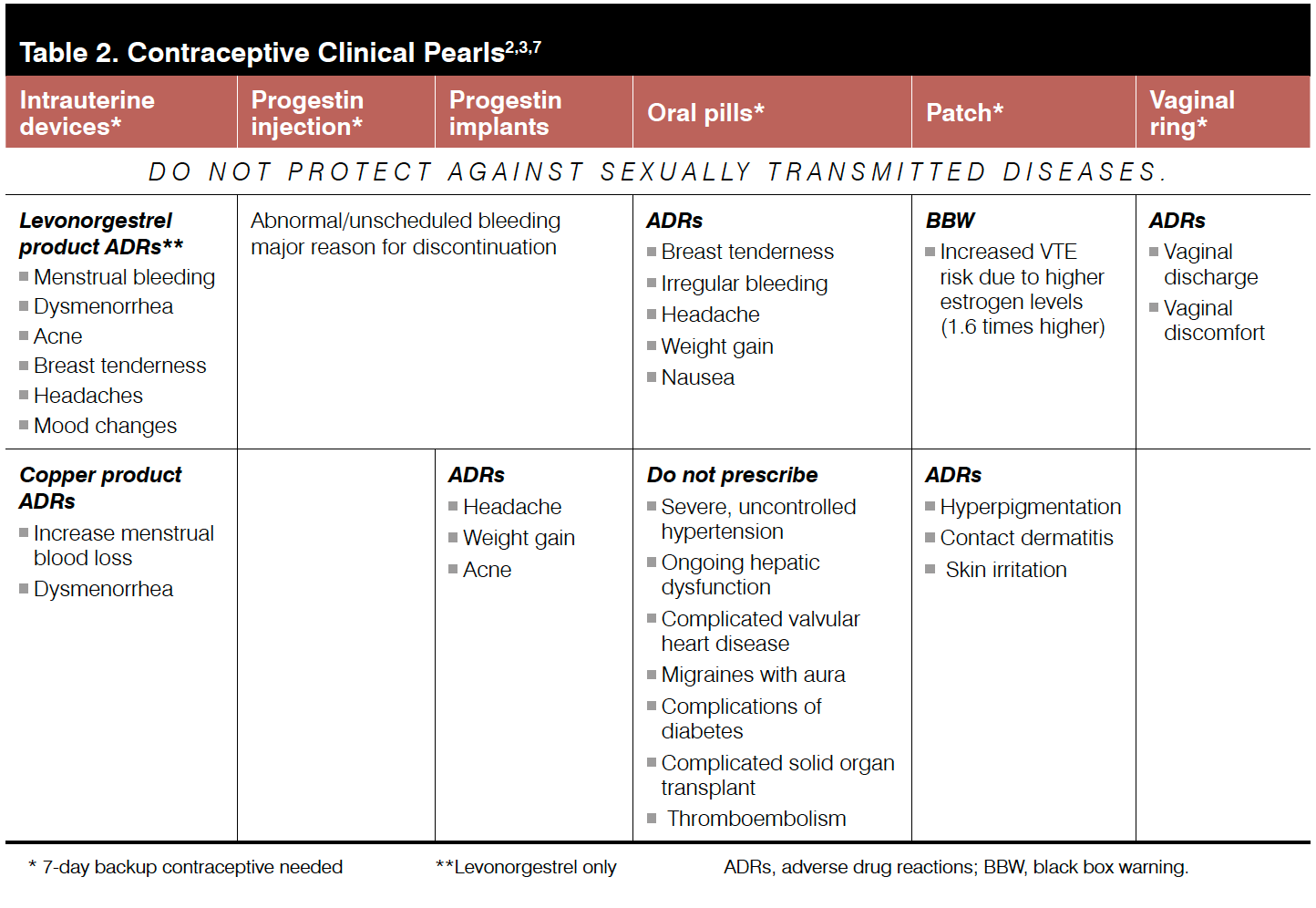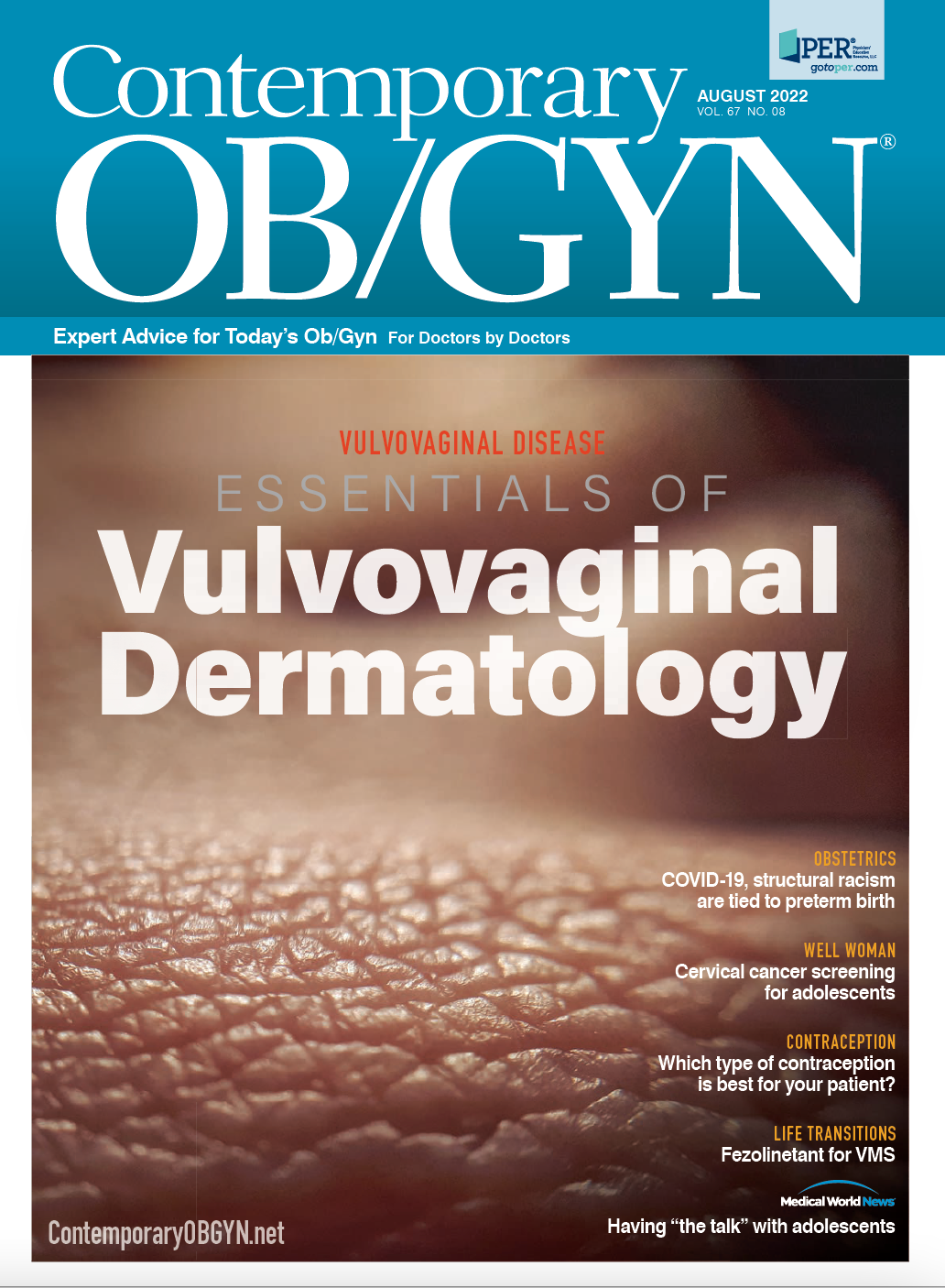Finding the best fit
Best practices on discussing birth control for adolescents.
Counseling patients about methods of contraception and increasing access to care can help address unplanned pregnancies and sexually transmitted diseases.
Health care providers play an important role in adolescent sex education, including in discussions on contraceptive use.1,2 Adolescents may start engaging in sexual activity while undergoing the numerous physical and emotional changes that occur during their transformative period.3 By the age of 20 years, approximately 80% of young women have had sexual intercourse; however, adolescents (aged 15 to 19 years) have limited understanding of the various contraceptive methods available to them, and the lowest rates of contraceptive use.1,2 Counseling individuals about the various methods of contraception and increasing access to care can help address unplanned pregnancies and sexually transmitted diseases.3 As most females prefer oral contraceptives over other forms, such as injections, transdermal patch, and vaginal rings, familiarizing themselves with the safest and most effective use of all these products is good practice1,2 (Table 13). This article delves into the contraceptives available for adolescents and discusses their efficacy and safety.
Contraception
Various methods of contraception are available for adolescents3 (Table 22,3,7). Medical providers should counsel them on the efficacy, safety, and adverse effects of contraception,1 informing them about the most effective options. Contraceptive options from most effective to least effective are as follows: intrauterine devices/progestin implants, progestin injections, and combined oral contraception (pills, patch, vaginal ring).2 Regarding efficacy, discussing aspects of “typical” use and “perfect” use is also recommended. Perfect use is when a contraceptive is used correctly all the time, whereas typical use takes human error into account;1,2,3 this includes missing pills or forgetting to change a patch, as well as using a condom.1,2 Common adverse effects are listed in Table 2.
Intrauterine contraception
Intrauterine devices (IUDs) are small, T shaped, and flexible. Currently, 3 are approved in the United States: levonorgestrel (Mirena) 52 mg, levonorgestrel (Skyla) 13.5 mg, and a copper-containing device (Paragard). Levonorgestrel 52 mg is approved for use for 3 years, levonorgestrel 13.5 mg for 5 years, and the copper IUD for 10 years.2,3 These devices are highly effective with a failure rate of less than 1%.2,3 Multiple data articles support the safety of these devices in adolescents.3,4,5 The one-time insertion of an IUD into the uterus reduces the risk of nonadherence,6 and thus the responsibility of maintaining effectiveness. This can make IUDs an ideal choice for a young woman who has not yet reached adulthood. The success rate for insertion is reported at 96%, but there is a risk of pelvic infection for the initial period (~21 days) after implantation. Choosing between the 2 different types of IUD can be challenging, but counseling patients about the risks and benefits with each option can help facilitate their decision. Counseling points to consider include the misconception of infertility with IUDs and safety in nulliparous females.1-3
Table 1. Effectiveness of Contraceptive Options.3

Table 2. Contraceptive Clinical Pearls.2,3,7

Progestin implants
A progestin implant is a thin, flexible, single rod containing etonogestrel, which is placed under the skin of the upper arm. Etonogestrel 68 mg (Nexplanon) is available and has 3 years of effectiveness. Implants are highly effective with a failure rate of less than 1%. These exert their action by thickening cervical mucous, thinning the endometrial lining, and inhibiting ovulation. Implants do not seem to have a high impact on bone mineral density as higher levels of estradiol are seen in females using implants versus a progestin injection. Implants are a great option for adolescents who prefer not to take scheduled medication daily or who prefer a longer length of protection.1-3,7
Progestin injection
Depot medroxyprogesterone acetate (DMPA; Depo-Provera) is an injection administered every 3 months with a 96% efficacy rate in pregnancy prevention. DMPA causes anovulation and thickening of the cervical mucous by inhibiting pituitary gonadotropins. Advantages of this product include infrequent dosing, discreteness, improvement in dysmenorrhea, and protection against iron-deficiency anemia and endometrial cancer. Disadvantages include having to access a health care provider for injections, menstrual cycle irregularities, delayed fertility return, weight gain, headache, and hair loss. Weight gain is a concern for adolescents who gain more than 5% of body weight after 6 months of use. A black box warning exists for the drug’s potential to cause bone mineral density loss in the first 2 years of use; however, the American College of Obstetricians and Gynecologists states no restriction on the length of time that DMPA can be used.1,2 During this time, adolescents should be counseled on adequate daily intake of calcium and vitamin D (1300 mg calcium; 600 IU vitamin D), weight-bearing exercises, and smoking cessation.1-3,7
Combined hormonal contraception
Three different methods exist which contain both an estrogen and progestin: pill, patch, and vaginal ring. The 4- to 7-day hormonal-free interval can be used monthly or extended to once every several months. Data have shown safety with the extended approach. Hormonal contraception needs to be taken for at least 21 consecutive days for efficacy against unplanned pregnancy. The timing of contraception use varies and should be taken into consideration when choosing between the pill form, injectable form, patch, or vaginal ring. Adolescents can start these products immediately or can wait until their next menstrual cycle. Preferring a Sunday start or starting on the first day of the next menstrual cycle is common. This will ensure the adolescent is not pregnant before starting contraceptives. Current data, however, do not support evidence of any adverse effects of contraceptive hormone exposure on fetal development.1-3,6
Combined oral contraceptive pills
Combined oral contraceptive pills are the most commonly prescribed hormonal contraception and contain various amounts of ethinyl estradiol. Providers should suggest strategies such as using cell phone alarms, maintaining a regular schedule, and getting family member support. Discussion of missed doses is very important, as taking 7 consecutive hormone pills is required to prevent pregnancy. Many different formulations exist (monophasic and in-phasic) and choosing an appropriate pill that is covered under the adolescent’s insurance is preferred. Experts recommend starting with a monophasic formulation and transitioning over to an in-phasic regimen to alleviate adverse effects and/or correspond with the adolescent’s preference.1-3,7
Contraceptive patch
Contraceptive patches (Xulane, Zafemy) contain 150 mcg norelgestromin and 35 mcg ethinyl estradiol. The patch is worn weekly for 3 weeks and removed for 1 week to induce a withdrawal bleed. The abdomen, upper torso, upper arm, and buttocks are safe places on which to place the patch.1,2,3,7
Contraceptive vaginal ring
The vaginal ring (NuvaRing) is a round, flexible device that is inserted into the vagina weekly for 3 weeks that contains 15 mcg ethinyl estradiol and 120 mcg etonogestrel. During the doctor visit, patients should be shown a pelvic model to help explain where the vaginal ring will be; they should be reassured the ring will not fall out and that it can remain in with sexual intercourse.1-3,7
This article was originally published by sister publication Contemporary Pediatrics®.
References:
- Ott MA, Sucato GS; Committee on Adolescence. Contraception for adolescents. Pediatrics. 2014;134(4):e1257-e1281. doi:10.1542/peds.2014-2300
- Committee on Adolescence. Contraception for adolescents. Pediatrics. 2014;134(4):e1244-e1256. doi:10.1542/peds.2014-2299
- Todd N, Black A. Contraception for adolescents. J Clin Res Pediatr Endocrinol. 2020;12(suppl 1):28-40. doi:10.4274/jcrpe.galenos.2019.2019.S0003
- Committee on Adolescent Health Care. Committee Opinion No 699: adolescent pregnancy, contraception, and sexual activity. Obstet Gynecol. 2017;129(5):e142-e149. doi:10.1097/AOG.0000000000002045
- Di Meglio G, Crowther C, Simms J. Contraceptive care for Canadian youth. Paediatr Child Health. 2018;23(4):271-277. doi:10.1093/pch/pxx192
- Kumar N, Brown JD. Access barriers to long-acting reversible contraceptives for adolescents. J Adolesc Health. 2016;59(3):248-253. doi:10.1016/j.jadohealth.2016.03.039
- Contraception explained: options for teens and adolescents. American Academy of Pediatrics. Updated July 20, 2020. Accessed April 27, 2022. https://www.healthychildren.org/English/ages-stages/teen/dating-sex/Pages/Birth-Control-for-Sexually-Active-Teens.aspx
Preference for alternative contraceptive sources reported by many patients
October 31st 2024With nearly half of short-acting contraceptive users preferring non-traditional sources such as telehealth and over-the-counter options, a recent study highlights evolving patient needs in contraceptive access.
Read More
Recap on reproductive rights with David Hackney, MD, MS
December 20th 2022In this episode of Pap Talk, we spoke with David Hackney, MD, MS, maternal-fetal medicine physician at Case Western Reserve University and chair of ACOG's Ohio chapter for a full recap of where restrictions on reproductive rights have been and where they're going.
Listen
In this episode of Pap Talk, Gloria Bachmann, MD, MSc, breaks down what it means to be a health care provider for incarcerated individuals, and explores the specific challenges women and their providers face during and after incarceration. Joined by sexual health expert Michael Krychman, MD, Bachmann also discusses trauma-informed care and how providers can get informed.
Listen

